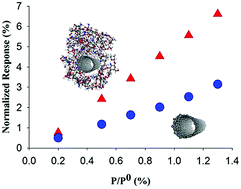Decoration of carbon nanotubes by chitosan in a nanohybrid conductive polymer composite for detection of polar vapours
Abstract
A new nanohybrid conductive composite was designed for detection of polar vapours and characterized based on thermodynamic parameters to investigate the sensor response. Poly(ethylene oxide) (PEO) and poly(vinyl alcohol) (PVA)–carbon nanotubes (CNTs) nanocomposite sensors were introduced to various organic vapours such as methanol, ethanol, isopropyl alcohol (IPA), chloroform and water. The response of these sensors was investigated based on thermodynamic parameters. Although, affinity is one of the most important parameters that can affect the response of sensors, the interaction parameter (χ) proposed by Flory and Huggins, cannot clarify the response trend for these series of nanocomposite transducers. We interpreted the response trend of transducers based on the polarity contribution of the Hansen solubility parameter. Thus, by designing a new nanohybrid nanocomposite, the sensor response against polar vapours was improved. New active sites in conductive polymer composites (CPCs) were designed by decoration of CNTs with chitosan (a polar biopolymer) and introducing of these new conductive particles to PVA and PEO. The wrapping of chitosan around CNTs was further investigated by molecular dynamics (MD) simulations. The polar functional groups of chitosan enhanced the driving force for diffusion of polar molecules into the nanohybrid composite and adsorption on the surface of CNTs and subsequently improved the sensor response.


 Please wait while we load your content...
Please wait while we load your content...